Macro photography is a complex topic, so selecting the best lens for macro photography isn’t just about selecting one lens and then being done with it. That’s just the starting. But before that, I’d like you to understand more about macro photography and the unique restrictions that it has
When objects in front of a lens are captured at almost the same size (1:1) on the camera’s sensor, that is Macro Photography. For this, special lenses are used. These lenses are typically able to focus very near the front element of the lens. Their design and clarity need to be exceptional in order to get pleasing results.
So, let’s look at what Macro Photography is, and which lenses are likely to suit your needs the best.
What is Macro Photography?
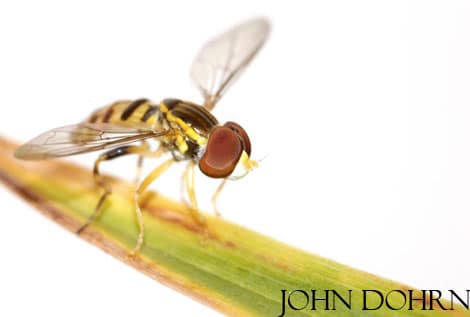
Macro Photography reproduces objects at larger-than-life sizes on print or screen.
However, the images start off being close to actual size when rendered on the camera’s sensor (or frame of film).
When these images are enlarged – as all our pictures are – they become much larger than real life, taking us into a realm where real, everyday objects become surreal worlds.
Perhaps this is where our fascination for macro photography comes from, the ability to change our everyday, ordinary world into an extraordinary one by the simple act of switching lenses.
In more technical terms, macro photography involves capturing objects at close to, or greater than 1:1 magnification. For example, a 5mm disc when photographed, would produce an image on the camera sensor where the disc is 5mm in size. Of course, this becomes much larger when viewed on a larger screen.
Selecting a Macro Lens
Since this series of posts is solely about lenses for various kinds of photography, we’ll deal only with lenses. You should know that there are other accessories (such as extension tubes and bellows attachments) available to the photographer that allow for magnifying a subject at 1:1 ratio. However, these are outside the scope of this article.
Check out our Lens Suggestions at the end of the article
The Best Focal Length Lenses for Macro Photography
Macro prime lenses are available from 24mm to 180mm. However, the most comfortable and versatile focal length for macro photography is probably the 100mm macro lens.
When you look into macro lenses, you’ll find that there are some prime lenses that give you 1:1 magnification at 50mm, while others will give you the same at 100mm or even 200mm.
The difference between these lenses is the minimum focusing distance, the depth of field, and the perspective which each focal length offers to the photographer.
50mm Macro Lens vs 100mm Macro Lens
While the 50mm macro will make you go really close to the subject, the Canon EF 180mm L lens allows you to stand far away (about 0.25m). The Nikon 200mm IF-ED Lens allows you to stand even further away – .5m away while still getting 1:1.
Big deal, you may say – all I’ve got to do is take a couple of steps forwards, and it’s all the same with the cheaper 50mm lens… well, not really.
A longer Minimum Focus Distance means that you get the same magnification without having to disturb the creature you’ve got that lens trained on… and that makes a big difference. It also means that you will have more space to work with artificial lighting.
Magnifying Objects to More Than 2X
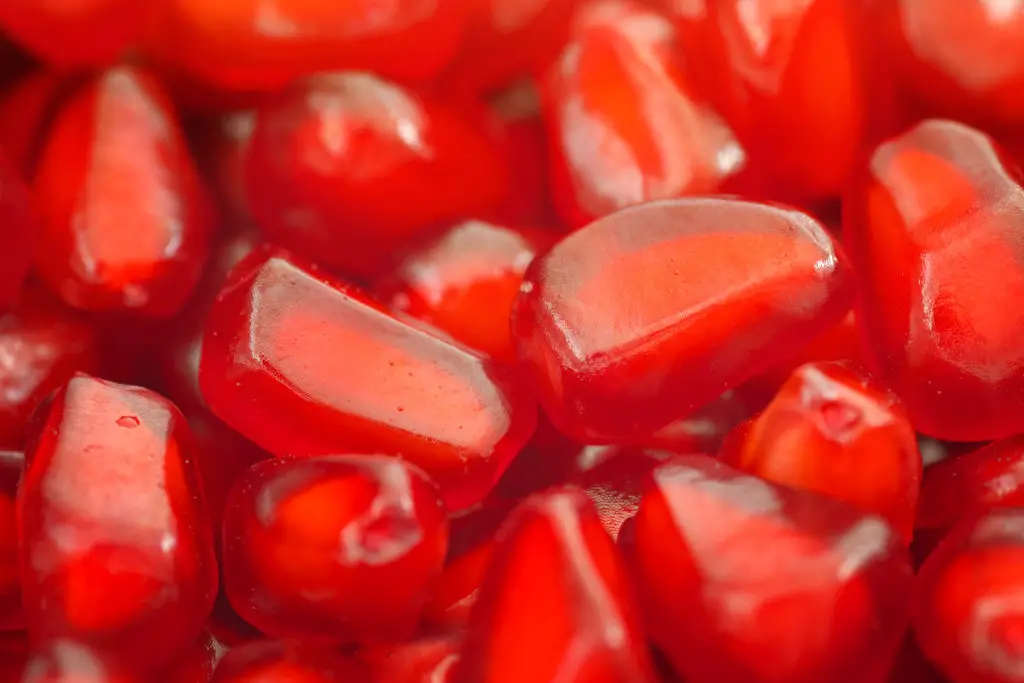
Usually, getting a magnification greater than 2:1 (image formed on the focal plane is 2x actual size) would involve getting an extension ring set, or a teleconverter, or a bellows arrangement, and possibly using them together.
However, the Canon MP-E 65mm f/2.8 1-5X Macro Lens (details below) has a magnification range of up to 5 times the actual size (5x or 5:1). Now, that kind of magnification combined with a high-resolution sensor will deliver results that are well worth the time and effort.
Using Macro Lenses for Portraits
Many, (but not all) of the Macro lenses listed here focus sharply on infinity and many photographers consider them to be exceptional portrait lenses. They offer fast focusing and high contrast – sometimes too much contrast.
Some photographers consider these lenses to be too sharp to create a pleasing image, and I can see their point. Nobody wants to see their every pore in greater-than-HD clarity.
Do You Need Image Stabilisation (IS) for Macro Photography?
Yes, you may need optical image stabilization (OIS or IS) for your macro photography. This is more important if you plan on doing any hand-held macro photography outdoors.
Most macro photography is done with the camera on a tripod. If that is the case, then you probably don’t need image stabilization (IS), vibration reduction (VR), or optical steady shot (OSS). Besides, your camera may already have IBIS (In-Body Image Stabilisation), so these shake reduction mechanisms may not be required.
However, as a nature photographer who may have to do a lot of macro photography hand-held, any shake reduction is a godsend. If there is any chance that you may do even a little bit of macro photography off a tripod, I think optical shake reduction mechanisms are essential.
Macro Photography Accessories
Given that dedicated macro photography requires a lot more control than most other genres of photography, there are a number of accessories that are suggested as well as required. I would broadly classify them as:
- Optical Accessories
- Support accessories
- Lighting accessories, and
- Accessories that make life easy
Here’s a list of accessories that I think would be essential for serious macro photography, or as a profession. If you have any suggestions, leave them in the comments below, and I’ll add them in.
- A sturdy tripod that can extend forwards
- Remote trigger (shutter release)
- Macro focusing rail (focusing rack)
- Ring Flash for macro lens
- Extension tubes (a last resort)
- Bellows
Unique Macro Lenses
Two important mentions are the 24mm Venus Laowa Probe Lens and the Canon MP-E 65mm 1-5X Macro lens.
Venus Laowa 24mm f/14 2X Macro Probe Lens
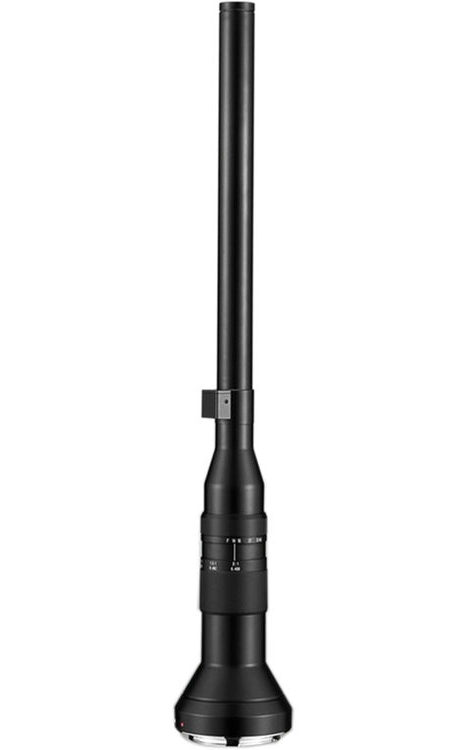
The Venus probe lens looks nothing like a conventional lens. However, it is a lens that can provide unique views of the world.
Considering that it is a probe lens, Venus has given it built-in LEDs to illuminate the area just in front of the front element. You may have seen videos taken using this lens without even knowing about the lens itself.
It has a 1.5ft minimum focusing distance, is macro focused, and offers a 2:1 magnification at that distance.
The probe design is useful… It gives you space to place additional lighting around the lens itself and pushes the camera way back from the subject so that operation is easy.
The 24mm focal length means that it gives you a lot more depth of field. The lens is also able to focus right up to infinity.
Canon MP-E 65mm f/2.8 1-5x Macro Photo Lens
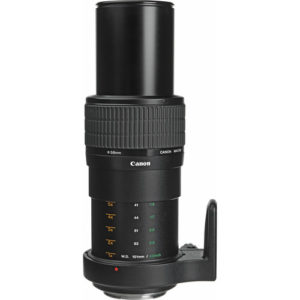
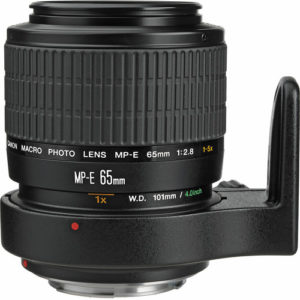
This Canon EF lens is another unique-looking lens. Just take a look at the size difference as you shift focus. The magnification increases all the way up from 1:1 to 5:1! Incredible!
As you can imagine, this lens is difficult to use, as it is manually focused. If you are really specializing in Macro photography, you already know about this legendary lens. You will most likely need to use focus stacking techniques, and focus stacking rails.
Ideally, you’d already have some macro photography experience to get the most out of this lens, as it is not easy to work with. There is a steep learning curve, so it would probably not be the best choice as your first macro lens.
The lens does not focus up to infinity and is best used in a studio setting where there are powerful lights.
Suggestions for The Best Lens for Macro Photography
As usual, we’ll have a collection of Macro Lenses with links. Of course, Sigma and Tamron also make excellent budget Macro Lenses, but my personal preference is to stick to brand lenses for this purpose.
Canon EF Macro Lenses
- Canon EF 50mm f/2.5 Compact Macro Lens – 1:2 Magnification
- Canon EF-S 60mm f/2.8 Macro USM Digital SLR Lens – Made for the EF-S Mount
- Canon EF 100mm f/2.8 Macro USM Lens – Considered by many as an outstanding Portrait lens too
- Canon EF 100mm f/2.8L IS USM Macro Lens
- EF 180mm f/3.5L Macro USM
Canon Manual Focus Macro Lenses
- Canon MP-E 65mm f/2.8 1-5X Macro Lens – incredible 5X magnification packed into one lens
Canon Mirrorless RF Macro Lenses
- RF 100mm f/2.8 L Macro IS USM – A beautiful lens!
- Canon RF 85mm F2 Macro is STM, Medium-Telephoto Lens
- Canon RF 35mm f/1.8 IS Macro STM Lens
Sony FE Macro Lenses
Macro Lenses for Nikon
- Nikon 60mm f/2.8D AF Micro-Nikkor Lens
- Nikon 105mm f/2.8G ED-IF AF-S VR Micro-Nikkor Lens
- Nikon AF Micro-Nikkor 200mm f/4D IF-ED Lens – 1:1 at .5 meters away
Nikon Manual Focus Macro Lenses
- Nikon PC-E Micro Nikkor 85mm f/2.8D Manual Focus Lens – Interesting for its ability to double both as a Perspective correction lens and a Macro Lens.
- Nikon 105mm f/2.8 Micro-Nikkor
- Nikon 55mm f/2.8 Micro-Nikkor
Venus Laowa
- Venus Laowa 24mm f/14 2X Macro Probe Lens with Built-in Ring Light – Such a unique lens!
- Venus Laowa 100mm f/2.8 2X Ultra Macro APO Lens for Canon RF
Do you own any of the lenses above? Do share your experiences with them in the comments below.
The Next Step in Macro Photography
Macro lenses aren’t the final step in macro photography. They’re simply the easiest.
Macro photography can be taken to the next level with equipment such as bellows for macro photography, extension tubes, macro focusing rails, automated focus stacking racks, and specialized lighting equipment that is designed specifically for macro photography.
On the software side, focus stacking allows multiple images to be combined for greater depth of field. Coupled with automated focus stacking racks, software like Affinity Photo and Helicon Focus create images that can’t be achieved with lenses alone.
When you have mastered your macro photography techniques with the lenses listed above, and find that they’re ‘cramping your style’, that’s when it’s time to expand your equipment.
The BPT Lens Resource
You can also find out more about lenses for specific kinds of photography at The Lens Resource index post.
If you found this interesting and would like to view further articles in a feed reader, add our RSS feed now. Also, if you’re interested in doing different things with your photography, look at our Photo Projects series.
Help Us To Continue Creating
Get our email newsletter to stay up-to-date with our latest posts. It’s easy to read and is mailed once in 2 weeks.
The easiest way to support Beyond Photo Tips is by using our affiliate links when you buy anything at all. It will never cost you anything extra, and we get a small commission from it, which helps us a LOT! We share our recommended equipment list here.
Some of the links to products on this website are affiliate links, and we only ever link out to gear that we recommend.
You could also show your appreciation by buying us a coffee. Finally, we appreciate you being a part of the community, so do say hi!

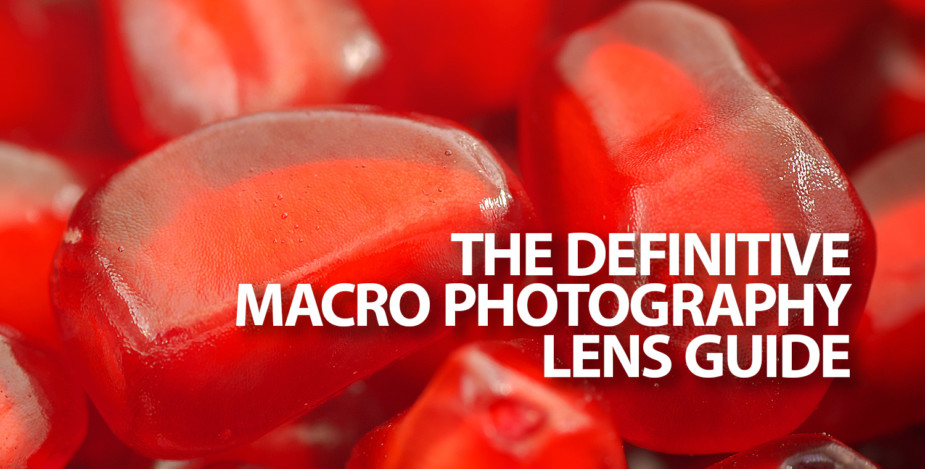
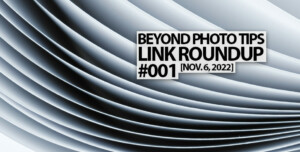

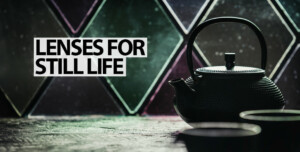

Dear Sir
regarding Macro photography
I wish to take a photos of the human Iris
most equipment for this purpose using the 15MP Canon T1i E or the 18MP Canon T2i EF-S. With Canon105mm macro lens
the Flash can be seen in the two photos
my question are :
1, about the flash: where can I get such a flash where the flash marks land in the pupil as in the photo.
2, about the lenses :is it making any different if it is f/2.0 ; f/2.8; f/3.5 or the 105mm to the 100 mm or the 150mm 180mm etc since I intend to take the photos from a stand about 3” from the eye about
thanks
veda
the pictures mentioned can be seen at the following link
http://www.facebook.com/media/set/?set=a.10150488049251602.388790.692171601&type=1&l=952dbc4f06
Dear Veda,
Thanks for stopping by BeyondPhototips.
The flash’s highlight comes from some sort of macro-flash. I find that it looks rather disturbing. Perhaps you could look into getting a ring flash…
Aperture (f/2.0, f/2.8, etc) makes a huge difference, as does focal length. They both impact the depth of field (area in focus). Small f numbers and long focal lengths give you small depth of field (less area around the plane of focus is sharp) and large fnumbers (f/22, f/26 etc.) and shorter focal lengths give you greater depth of field.
Hope that helps.